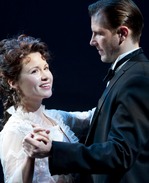The Orphans' Home Cycle Part Two at the Signature Theater
By Elyse Sommer
| I am no orphan, but I think of myself as an orphan, belonging to no one but you. I intend to have everything I didn't have before. A hose of my own, some land, a yard, and in that yard I will plant growing things, fruitful things. . .and I do believe I might now have these things, because you married me.— Horace, in Act 3: Valentine's Day. |
 Maggie Lacey and Bill Heck (Photo by T. Charles Erickson) |
The more upbeat story we're about to witness is launched with another of the stunning opening scenes that director Michael Wilson has created to stitch these former stand-alone plays into a big, beautiful, finely shaded patchwork. We again see Horace (another deeply felt performance by Bill Heck) wandering across the stage as a series of moving panels spell out the title. That suitcase symbolizes the loneliness and yearning that haunts fatherless men. To establish the more hopeful part of this epic journey, Horace is surrounded by pairs of dancing ensemble members.
The story of Horace's short-lived romance with the beautiful young widow, Claire Ratliff (Virginia Kull), and his courtship and marriage to Elizabeth Vaughn (Maggie Lacey) is, like the entire Cycle, propelled by subtle details and ordinary conversations rather than any explosive or suspenseful plot developments. It is Horton Foote's ability to engage us in the very ordinariness of these lives that makes these stories as riveting as any play full of edge-of-the-seat action and suspense.
The delicate shading of Foote's storytelling and the nine plays' thematic connection is smartly underscored by the way the actors are cast to play a variety of roles. To give just one example, the opening act of Parts One and Two are smartly linked together by the fact that Virginia Krull plays both Horace's widowed mother in the first part and the young widow he's smitten with in the second, and that Dylan Riley Snyder metamorphoses from Horace at age 12 to the Widow Claire's son Buddy (in another standout performance).
We thus have two different women played by one actress faced with and settle for pragmatic choices and we see Horace and Buddy linked by the multiple role casting as they share the pain of losing a father at an early age that can never quite go away. There's yet another variation on saga's invisible and unerasable scar of experiencing a father's death at a young age (and so accounting for the plural of the title's Orphans): Horace's initially antagonistic father-in-law Mr. Vaughn (James DeMarse) was also half-orphaned at age twelve which makes you understand his over-protectiveness of his daughter which initially makes him come across as smug and dictatorial. DeMarse makes a tour-de-force transition from a drunken character in the somewhat gothic Convicts of Part One to the successful business owner and family man Horace yearns to be. As Lauren noted when she reviewed this segment in Hartford, the bond that forms not only between Horace and Elizabeth but between him and her family makes for some powerfully moving moments.
For audience members who see Part two without having seen Part 1, the program includes a handy summary and I assume this will be true for Part three which will take us forward to the next decade of life in Harrison, Texas. Naturally, no summary can do justice to seeing Horace's epic journey unfold on stage and watching stellar ensemble members like Hallie Foote, Annalee Jefreys and Pamela Payton-Wright amaze us once again with their persona changing virtuosity.
With the concluding triptych of the Cycle titled 1918 it seems inevitable that Harrison's citizenry wil be affected by the Spanish flue epidemic and the first World War. It might not be a bad idea to come with plenty of tissues. Serious challenge
Part One: The Story of a Childhood: 1902-1910 Prologue and Act 1: Roots in a Parched Ground 1902-1903. . .Act 2: Conficts 1904. . .Act 3 Lily Dale 1911
Part Three: The Story of a Family 1918 . . . Cousins . . . The Death of Papa - reviewed at Hartford Stage